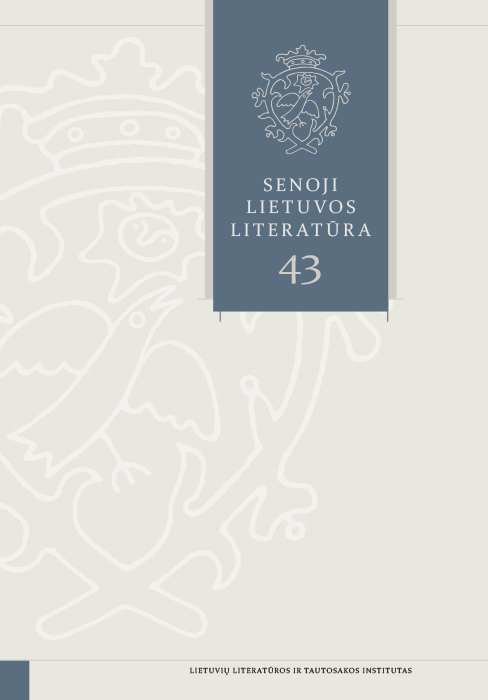Ultima serva: the Letters of Helena of Moscow
Abstract
At the centre of this paper is Helena of Moscow (1476–1513) of the Rurik dynasty, the daughter of Ivan III, Grand Prince of Moscow, and his second wife Sophia Palaiologina, and her letters. Helena married Grand Duke of Lithuania Alexander in 1495 and became Grand Duchess of Lithuania. The research material for this paper consists not only of the letters attributed to this female ruler, but also of the letters of her correspondents, which help to reveal both a broader context of her correspondence and the possibilities and peculiarities of her correspondence. The author of the study analyses the aim and purpose, the content and structure of her letters, raises the issues of the authorship, the precise number of extant letters and their dating. The letters of Helena of Moscow to Ivan III (1503) and her letter in Latin to Cardinal Friedrich and Polish bishops (1502) are analysed in a greater detail.
The number and dates of Helena’s extant letters were specified after the analysis. There exist six letters in Russian written in the name of this female ruler: four were written on 2 January 1503 to her father, mother, and two brothers, and two letters, of 17 July 1495, to her father and mother. There is also one letter in Latin, which on 28 September was written to Cardinal Friedrich and Polish bishops. Hypothetically one might say that on the textual and ideological level her letter in Latin is related to her letters in Russian that she wrote to her family in 1503, and to the texts of Alexander’s legation to Ivan III in the spring of 1503.
Helena’s letters were written following the principle of ‘collaboration’: they are a joint endeavour of the ruler herself, the chancellery, and the people of her environment. Almost all of them can be at least with some reservations attributed to the category of diplomatic letters the content of which contains themes of a personal nature. Helena’s correspondence was used as a political instrument in the advancement of state interests, both by her father and her husband. The letters of the ruler that survived in the books of diplomatic records are particularly closely related to the ‘speeches delivered’ to the intended addressees through the lips of the envoys, to the plenipotentiary letters prepared in her name, and to the texts of the legations of her husband Alexander. This is demonstrated by recurrent almost identical phrases, the same lexicon, a similar layout and structure, addresses and epithets, the adaptation of the text to the status of the addressee in the ruling hierarchy and inside the family.
Although it is difficult to arrive at decisions and draw serious conclusions from just one extant Helena’s letter in Latin, but, against the context of European Latin letter writing and letters of other male and female rulers of the Grand Duchy of Lithuania, it could be possible to indicate with caution that there exist numerous associations between Latin and Russian epistolography. Epistolary salutations, formulae of politeness, the structure of address, and opening phrases that circulated in European Latin and Slavic spaces of that time and the key elements of the letter structure are very similar and standardized. Meanwhile, the expression and style of an epistle depend, in one way or another, on the personality of the writer, the aims and the context of a letter.
In a concise manner, the paper also dwells on the presumed correspondence of Elisabeth of Austria, Queen consort of Poland and Grand Duchess of Lithuania. Information on her correspondence comes only from the letters of her correspondents, who are exclusively members of her family (sons Alexander, Wladislaw, and Friedrich). The themes of mutual correspondence included matters related to the family, economy, and politics.
Most read articles by the same author(s)
- Dovilė Keršienė, Viktorija Vaitkevičiūtė, Mintautas Čiurinskas, Chronicle , Senoji Lietuvos literatūra: Vol. 38 (2014): Senoji Lietuvos literatūra
- Mintautas Čiurinskas, Simona Jaskelevičiūtė, Dovilė Keršienė, Ligita Mikulėnienė , Živilė Nedzinskaitė, Ona Petrėnienė, Kotryna Rekašiūtė, Chronicle , Senoji Lietuvos literatūra: Vol. 44 (2017): Senoji Lietuvos literatūra
- Darius Antanavičius, Dovilė Keršienė, Sigitas Narbutas, Živilė Nedzinskaitė, Annotations , Senoji Lietuvos literatūra: Vol. 37 (2014): Senoji Lietuvos literatūra
- Dovilė Keršienė, Desiderium videndi: Correspondence between Barbara Zápolya and Sigismund the Old , Senoji Lietuvos literatūra: Vol. 47 (2019): Senoji Lietuvos literatūra
- Dovilė Keršienė, Illustrissima princeps, serenissima regina et domina clementissima: Epistles of Female Rulers and Noblewomen of GDL in the Late Fourteenth – the First Half of the Sixteenth Century , Senoji Lietuvos literatūra: Vol. 38 (2014): Senoji Lietuvos literatūra
